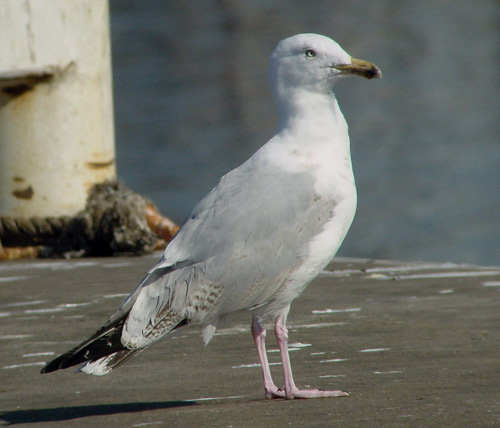 Herring
Gull - Zilvermeeuw (argentatus & argenteus): sub-adult March
Herring
Gull - Zilvermeeuw (argentatus & argenteus): sub-adult March
(last update: 08 december 2003)
Home
Links
to Gull Sites
Gull Taxa
Gull Topography
Grey & Colour Charts
Locations in NW Europe
Summaries of Articles
About ORG
@
Herring Gull 4cy (argenteus), March 16 2003, Boulogne-sur-Mer, France (50.42N,1.34E).
The scapulars appear completely adult-like grey but in
the wing-coverts and on the tertials much vermiculated brown-black
markings are visible. Probably, the upper tertials were once replaced in the partial autumn
moult and it might be one generation older than the other tertials. The greater coverts were moulted in two waves which met
about at #7-#8. The greater coverts were replaced last in line and
consequently they appear much plainer grey. So,
although these greater coverts most probably belong to the same (third)
generation, there are clear and obvious differences between the first
moulted coverts (the very abraded inner greater coverts #4-6) and the most
recently moulted coverts (#7-#8).The three innermost greater coverts, like the upper
tertials, are probably one generation older.
The outer primary-covert
are dark, unlike the grey adult-like primary-coverts of 5cy and older
birds. Last autumn, so-called "third winter" birds (4cy by
February) have replaced the all-brown immature primaries for more
adult-like primaries, which show a white tip, a grey basal half and one or
two mirrors (P9 and P10). But still the size of the dark patches and the
amount of black in the outer primaries is more extensive when compared to
adults: there is often a broad dark sub-terminal band on P5 and a dark
faint spot on the outer-web of P4. The dark patches are not sharply
demarcated as in adult, but the dark outer-web gradually dissolves in the
grey inner-web. Note the dark vermiculated markings on the tail-feathers
in this individual.
From January to April, 4cy argenteus moult to so-called "third summer" plumage. By April, the head and under-parts will appear all-white. The tail-feathers, wing-coverts and primaries are not replaced, therefore most birds strongly resemble "third winter" birds, although the white primary tips wear away and dark patches start to bleach. The iris is often yellowish, the orbital ring yellowish-orange and the bill predominantly yellow with a red gonydeal spot and limited black markings along the culmen by April.
